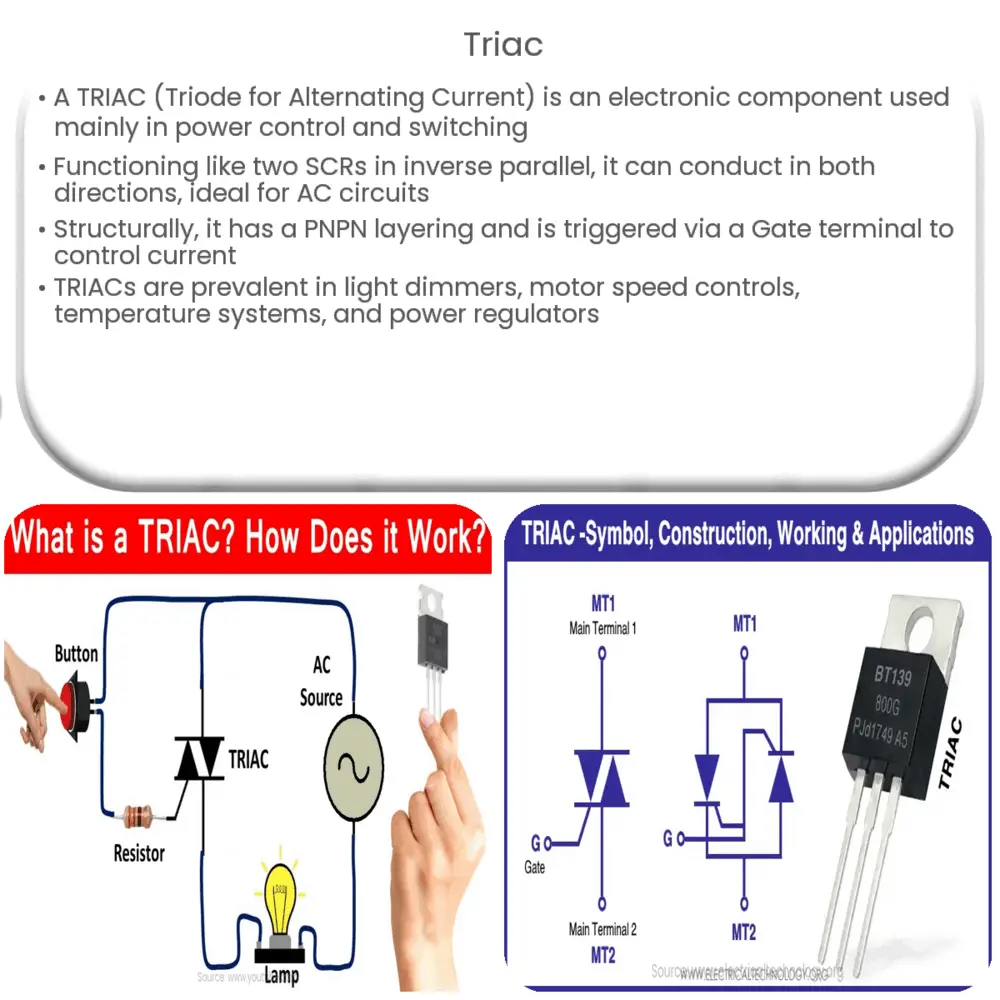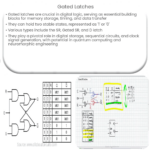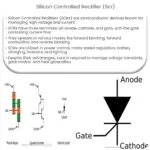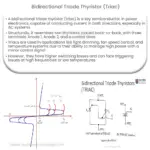Explore the TRIAC’s structure, operation, and diverse applications in power control, from light dimming to motor speed regulation.

Understanding the TRIAC
A TRIAC (Triode for Alternating Current) is a three terminal electronic component that is used primarily in power control and switching applications. The term “TRIAC” is a portmanteau derived from the words triode and alternating current, illustrating its function and its field of use.
Functioning much like a pair of Silicon Controlled Rectifiers (SCRs) joined in an inverse parallel connection, the TRIAC is capable of conducting in either direction when it is properly gated. This capability makes it an ideal component in AC circuits where control of high voltage and high current is required.
Structural Composition and Operation
The structure of the TRIAC is somewhat complex, consisting of several layers of semiconductor material. It incorporates N and P type materials in alternating layers, forming a PNPN structure. This layered structure is what allows it to control the current flow in both directions, offering an advantage over SCRs which can only control current in a single direction.
- Main Terminals (MT1 and MT2): The main terminals, also referred to as anode 1 and anode 2, are the two ends between which conduction takes place.
- Gate Terminal: The Gate terminal is the control terminal, which regulates the flow of current between MT1 and MT2. Applying a small voltage to the gate allows a larger current to flow between the main terminals.
Applications of TRIAC
TRIACs are widely utilized in various applications because of their ability to control large power and voltage. These are some common areas where TRIACs are found:
- Light Dimming Circuits: TRIACs are commonly used in light dimming circuits. By controlling the conduction angle (the portion of the AC waveform during which the TRIAC conducts), the brightness of the light can be adjusted.
- Motor Speed Control: Similar to light dimming, TRIACs are used in controlling the speed of AC motors. By adjusting the conduction angle, the speed of the motor can be regulated.
In the next section, we will dive deeper into the specifics of how TRIACs function, how they are used in circuit design, and further applications.
Functionality and Circuit Design
The TRIAC operates by triggering. Once a small current is applied to the Gate terminal, the TRIAC starts conducting between its two main terminals. It will continue to conduct until the current drops below a certain ‘holding’ value. The TRIAC has two triggering modes:
- Positive Gate Current: This occurs when the gate current is positive and the MT2 terminal is positive with respect to MT1.
- Negative Gate Current: This occurs when the gate current is negative and the MT2 terminal is negative with respect to MT1.
The design of a circuit using a TRIAC often involves a ‘snubber’ circuit, which is used to prevent false triggering caused by voltage spikes and transients in the system.
Further Applications
Beyond light dimmers and motor speed controls, TRIACs are also used in other applications such as:
- Temperature Control Systems: In temperature control systems, TRIACs can be used to regulate the power supplied to heating elements, thus maintaining the desired temperature.
- Power Regulators: TRIACs are used in AC power controllers where the output is varied by controlling the amount of input voltage or current.
Conclusion
In conclusion, a TRIAC is a powerful electronic component that allows for sophisticated control of power and voltage in AC circuits. Its ability to conduct in both directions, triggered by a simple gating signal, makes it a versatile tool in many electronic devices and systems. Whether in basic household applications such as light dimming and motor speed control, or in more complex industrial applications like temperature control systems and power regulators, the TRIAC plays a critical role in our everyday lives. As technology continues to evolve, so too will the applications and capabilities of the TRIAC.




